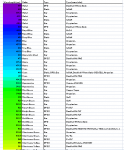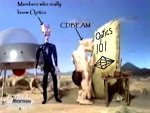Yeah, that Oclaro 635nm 700 mW diode has the same divergence as the Mits ML501P73....horrid! It will be a challenge to get that beam shaped to match a green. UK spent a lot of time and money getting all the parts together to build the 577nm he has. Is has a separate heat sink assembly larger than the laser head to manage the enormous amount of heat generated by the 40 watt IR diodes package. The head is bolted down to the heat sink assembly through two 8 amp TECs to a much larger heat sink which is fan cooled. Very loud fan. The driver is adjustable and the whole package is about 7 years old.... so very expensive.
Can't wait to see how you match these beams and how close you are able to get to a lime green color. I am working with diodes that can provide that color at 120 mW alone. It's all very interesting. :thanks:
So...." Where's Waldo "...and where is Lime Green ?????
See attached Color Pic...
I would say Lime Green lives somewhere between 540nm and 550nm.
Our eye spectral sensitivity peaks for Day viewing @ 555nm and night viewing @ 507nm...see Wiki ...
https://en.wikipedia.org/wiki/Spectral_sensitivity
So...we get good luminosity at 540nm to 550nm !!
Why Lime Green....because........It is the most obtuse colour / line I can think of !!:wave: :tinfoil::tinfoil::tinfoil:...and...I like the colour !!!
What diode or diodes are you referring to deliver 120mW of Lime Green ???
Now...for divergence...I can get the Oclarro 63193/ Mitsu P73 down to 0.802mRad....and the NDG7475 down to 0.685 mRad....close...but not equal...
I Could always go with two (2) separate sets of C-Lenses !!! Not sure if there is enough room using the CC Build model ???
Well....anyway....I have enough projects stacked up for several years !!!...I will just throw this one on da pile !!:san:
Has anyone combined a corrected Red and a corrected Green LD ??????

Anyway....thanks for Brainstorm'in with me !!!
Later,
CDBEAM







